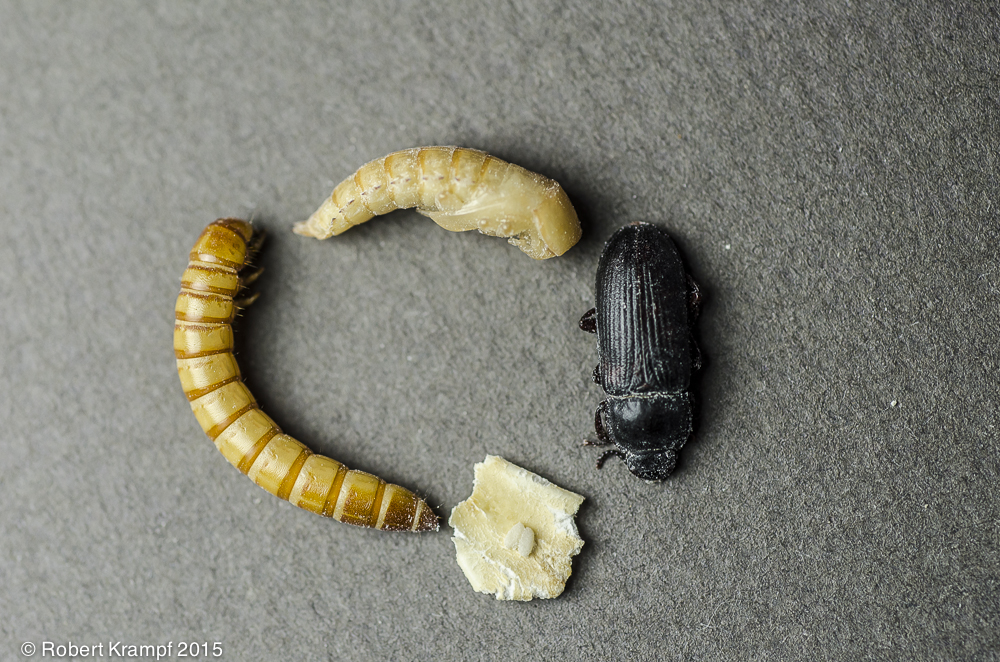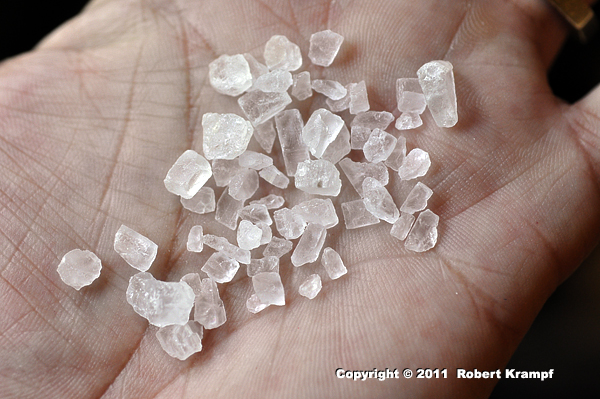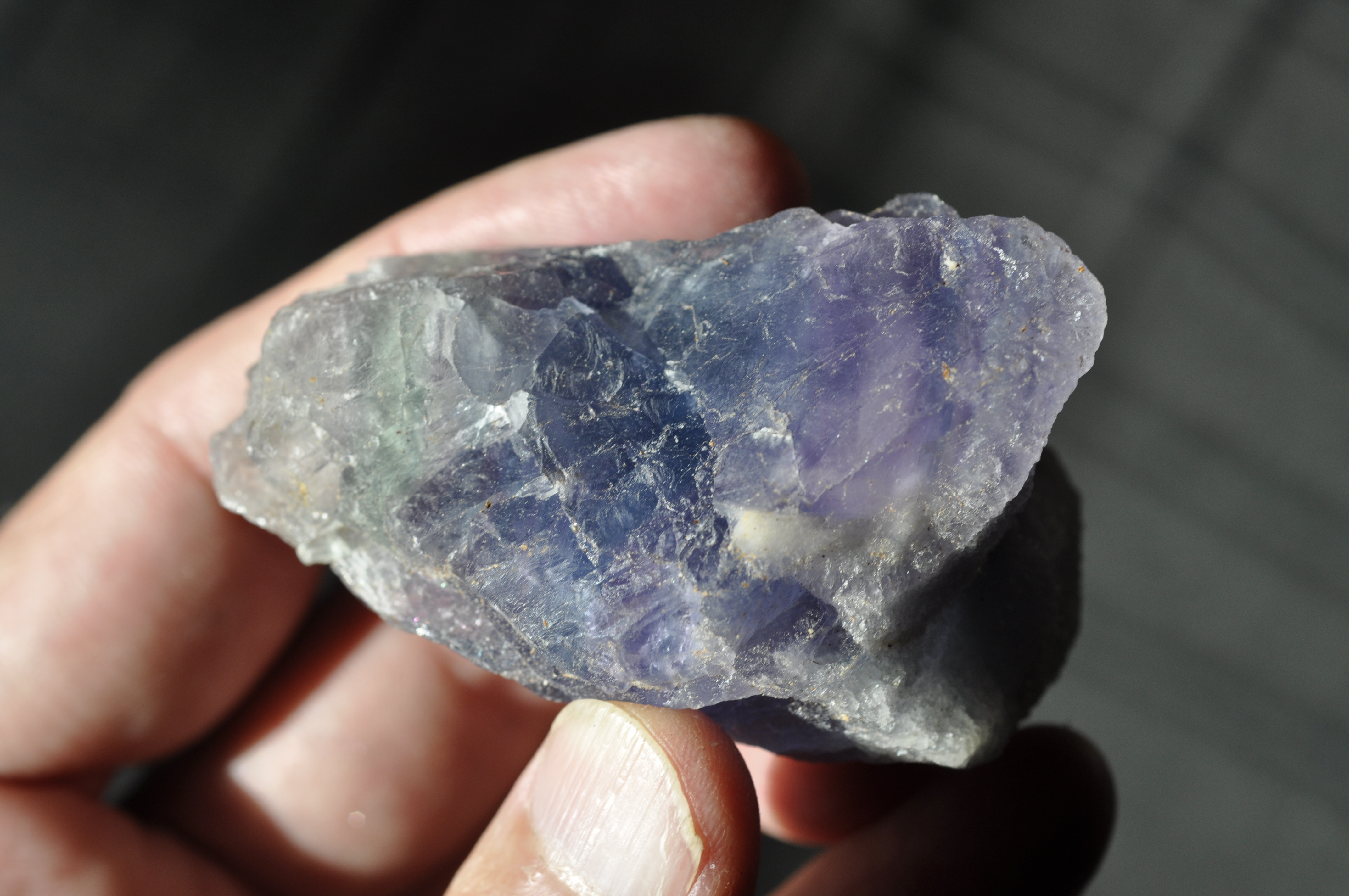Here are some science questions from the Standards for Grades 2-5 to help you test your knowledge of the Next Generation Sunshine State Standards.
The questions are chosen randomly, so this quest will be different each time you reload the page.
* Click here to see only the most recently added questions.

These are the four stages of a mealworm's life cycle. What kind of life cycle is it?
-
Incomplete metamorphosis
No. For an incomplete metamorphosis, there are only three stages: egg, larva, and adult. The young also look very similar to the adults. The mealworm larva looks very different from the beetle. -
Complete metamorphosis.
Yes! For a complete metamorphosis, the animal goes through four stages: egg, larva, pupa, and adult. -
Full metamorphosis.
No. There is no life cycle called full metamorphosis. -
Partial metamorphosis.
No. There is no life cycle called partial metamorphosis.
Click to see which state standards this question tests, and which of my videos, experiments, and other resources support that topic.
Florida
SC.2.L.16.1 Observe and describe major stages in the life cycles of plants and animals, including beans and butterflies.
| Seed Search | video, ClosedCaptions, checked |
| Review Life Cycle-1 | practice |
| Review Life Cycle-2 | practice |
| Review Life Cycle-3 | practice |
| Review Life Cycle-4 | practice |
SC.4.L.16.4 Compare and contrast the major stages in the life cycles of Florida plants and animals, such as those that undergo incomplete and complete metamorphosis, and flowering and nonflowering seedbearing
plants.
| Orange Slices | video, ClosedCaptions |
| Creating a Sprout Guide | text page, photography, free |
| Review Life Cycle-1 | practice |
| Review Life Cycle-2 | practice |
| Review Plants-4 | practice |
| Review Life Cycle-3 | practice |
| Review Life Cycle-4 | practice |
Utah
UT.5.V.1.c Compare various examples of offspring that do not initially resemble the parent organism but mature to become similar to the parent organism (e.g., mealworms and darkling beetles, tadpoles and frogs, seedlings and vegetables, caterpillars and butterflies).
| Review Life Cycle-1 | practice |
| Review Life Cycle-2 | practice |
| Review Life Cycle-3 | practice |
| Review Life Cycle-4 | practice |
NGSS
1-LS3-1 Make observations to construct an evidence-based account that young plants and animals are like, but not exactly like, their parents.
| Review Life Cycle-1 | practice |
| Review Life Cycle-2 | practice |
| Review Life Cycle-3 | practice |
3-LS1-1 Develop models to describe that organisms have unique and diverse life cycles but all have in common birth, growth, reproduction, and death.
| Review Life Cycle-1 | practice |
| Review Life Cycle-2 | practice |
| Review Life Cycle-3 | practice |

This is common, table salt. Is it:
-
a rock?
Partly correct. Table salt, also known as halite, is both a rock and a mineral. -
a mineral?
Partly correct. Table salt, also known as halite, is both a rock and a mineral. -
Neither a rock nor a mineral?
No. Table salt, also known as halite, is both a rock and a mineral.
Click to see which state standards this question tests, and which of my videos, experiments, and other resources support that topic.
Florida
SC.4.E.6.2 Identify the physical properties of common earth-forming minerals, including hardness, color, luster, cleavage, and streak color, and recognize the role of minerals in the formation of rocks.
| What is a Mineral? | video, checked |
| Identifying Minerals | video, learnalong |
| Definition of a Mineral | video, checked |
| Minerals Around You | text page, learnalong, checked |
| Review Minerals-1 | practice |
| Review Minerals-2 | practice |
| Review Minerals-3 | practice |
| Review Minerals-4 | practice |
| Review Minerals-5 | practice |
| Review Minerals-6 | practice |
| Review Minerals-7 | practice |
| Review Minerals-8 | practice |
Utah
UT.4.III.1.b Observe rocks using a magnifying glass and draw shapes and colors of the minerals.
| What is a Mineral? | video, checked |
| Identifying Minerals | video, learnalong |
| What is a Rock? | video, learnalong, checked |
| Definition of a Mineral | video, checked |
| Review Minerals-3 | practice |
| Review Minerals-4 | practice |
| Review Minerals-5 | practice |
| Review Minerals-6 | practice |
| Review Minerals-7 | practice |
| Review Minerals-8 | practice |
UT.8.III.1.b Observe and describe the minerals found in rocks (e.g., shape, color, luster, texture, hardness).
| What is a Mineral? | video, checked |
| Identifying Minerals | video, learnalong |
| What is a Rock? | video, learnalong, checked |
| Definition of a Mineral | video, checked |
| Review Minerals-1 | practice |
| Review Minerals-2 | practice |
| Review Minerals-3 | practice |
| Review Minerals-4 | practice |
| Review Minerals-5 | practice |
| Review Minerals-6 | practice |
| Review Minerals-7 | practice |
| Review Minerals-8 | practice |
NGSS
5-PS1-3 Make observations and measurements to identify materials based on their properties.
| Raw Egg or Boiled? | video, checked |
| Making Turmeric Paper | video, checked |
| Testing for Tannic Acid | video |
| Definition of a Mineral | video, checked |
| Floating Bubbles | video, checked |
| Finding Fat in Foods | video, ClosedCaptions, checked |
| Fireworks Colors | video |
| Iron Cereal | video, ClosedCaptions, checked |
| Density: Ice, Oil, and Water | video, checked |
| Wax and Wood, part 1 | video, checked |
| Wax and Wood, part 2 | video, checked |
| What is a Mineral? | video, checked |
| Identifying Minerals | video, learnalong |
| A Cool Change | text page |
| Acid Hunt | text page |
| Review Minerals-2 | practice |
| Review Minerals-3 | practice |
| Review Minerals-4 | practice |
| Review Minerals-5 | practice |
| Review Minerals-6 | practice |
| Review Minerals-7 | practice |
| Review Minerals-8 | practice |

I wanted to test a new fertilizer, to find the best concentration for my garden. I divided my garden into four sections and put a different amount of fertilizer in each section.
My test results showed that using 10 grams of fertilizer per gallon made the plants grow faster and bigger. To follow proper scientific guidelines, what should I do next?
-
Apply 10 grams of fertilizer per gallon to all the plants in my garden.
No. While that might make my garden grow well, it would not provide more evidence that this was the best mixture of fertilizer -
Do the same experiment over again.
Yes! Repetition is an important part of the scientific process. If my hypothesis is correct, I should get the same results every time I repeat the experiment. -
Do the same experiment, but use a different fertilizer.
No. Using a different fertilizer would be testing a different variable. I wanted to find the best concentration of the original fertilizer, so testing a different fertilizer would not help with that. -
Publish my results, so that other scientists could replicate my experiment.
No. Replication is an important step, but I should repeat my experiment several times to be sure that I get consistent results before I ask other scientists to try replicating it.
Click to see which state standards this question tests, and which of my videos, experiments, and other resources support that topic.
Florida
SC.2.N.1.4 Explain how particular scientific investigations should yield similar conclusions when repeated.
| What is Science? | video, ClosedCaptions |
| Review Scientific Process-6 | practice |
| Review Scientific Process-5 | practice |
| Review Scientific Process-7 | practice |
| Review Scientific Process-10 | practice |
SC.5.N.1.3: Recognize and explain the need for repeated experimental trials.
>>> Teacher Page: Nature of Science and Dissolving
| What is Science? | video, ClosedCaptions |
| What is Science?: Repeat and Replicate | video |
| Review Scientific Process-7 | practice |
| Review Scientific Process-10 | practice |
SC.8.N.1.2 Design and conduct a study using repeated trials and replication.
| What is Science?: Repeat and Replicate | video |
| Review Scientific Process-6 | practice |
| Review Scientific Process-5 | practice |
| Review Scientific Process-7 | practice |
| Review Scientific Process-10 | practice |
Utah
NGSS
3-5-ETS1-3 Plan and carry out fair tests in which variables are controlled and failure points are considered to identify aspects of a model or prototype that can be improved.
| What is Science? | video, ClosedCaptions |
| Review Scientific Process-1 | practice |
| Review Scientific Process-2 | practice |
| Review Scientific Process-7 | practice |
| Review Scientific Process-9 | practice |
| Review Scientific Process-10 | practice |
| Review Scientific Process-11 | practice |

Which of these sources of electricity is a renewable resource?
-
Coal
No. Coal is the fossilized remains of ancient plants, and it takes millions of years to form. -
Hydroelectric
Yes. The lake water that provides hydroelectric power is replenished every time it rains. -
Natural Gas
No. Natural Gas is a fossil fuel, and takes millions of years to form. -
Fuel Oil
No. Fuel oil comes from petroleum, which requires extremely long periods of time to form.
Click to see which state standards this question tests, and which of my videos, experiments, and other resources support that topic.
Florida
SC.4.E.6.3 Recognize that humans need resources found on Earth and that these are either renewable or nonrenewable.
| Recycle | video |
| Review Energy-4 | quest |
| Review Energy-1 | practice |
Utah
UT.8.II.3.a Describe specific examples of how humans have changed the capacity of an environment to support specific life forms (e.g., people create wetlands and nesting boxes that increase the number and range of wood ducks, acid rain damages amphibian eggs and reduces population of frogs, clear cutting forests affects squirrel populations, suburban sprawl reduces mule deer winter range thus decreasing numbers of deer).
| Investigating Acid Rain | video, checked |
| Quadrats and Population Sampling | video, ClosedCaptions |
| Review Energy-1 | practice |
NGSS
4-ESS3-1 Obtain and combine information to describe that energy and fuels are derived from natural resources and their uses affect the environment.
| Investigating Acid Rain | video, checked |
| Solar Power | video, checked |
| Review Energy-4 | quest |
| Review Energy-1 | practice |
MS-ESS3-1 Construct a scientific explanation based on evidence for how the uneven distributions of Earth’s mineral, energy, and groundwater resources are the result of past and current geoscience processes.
| Evaporites | video, learnalong, checked |
| What is a Mineral? | video, checked |
| Identifying Minerals | video, learnalong |
| Definition of a Mineral | video, checked |
| Review Energy-1 | practice |

This is called Fluorite. It is used in making many important chemicals. What kind of rock is it?.
-
Igneous
No. Igneous rocks formed from magma or lava. Fluorite is sometimes found as a mineral in igneous rock, but it is not an igneous rock. -
Sedimentary
No. Sedimentary rocks are deposited by wind, water, ice, or gravity, and they often contain fossils. Fluorite is not a sedimentary rock. -
Metamorphic
No. Metamorphic rocks have been changed by heat and pressure from a different kind of rock. Fluorite is not metamorphic. -
Fluorite is not a rock.
Yes! Fluorite is a mineral, not a rock. It is not found in large layers in the Earth.
Click to see which state standards this question tests, and which of my videos, experiments, and other resources support that topic.
Florida
SC.4.E.6.1 Identify the three categories of rocks: igneous, (formed from molten rock); sedimentary (pieces of other rocks and fossilized organisms); and metamorphic (formed from heat and pressure).
| Evaporites | video, learnalong, checked |
| Igneous Rocks and Bubbles | video, free, learnalong, Updated |
| Sedimentary Rocks | video, learnalong |
| What is a Rock? | video, learnalong, checked |
| Bioclastics: Rocks With No Minerals | video |
| Light and Dark Minerals | text page, learnalong |
| Homemade Fossil Dig | text page |
| Foliated and Unfoliated Rocks | text page, learnalong |
| Identifying Igneous Rocks | text page, learnalong |
| Intrusive and Extrusive Igneous Rocks | text page, learnalong |
| Review Rocks-2 | practice |
| Review Rocks-3 | practice |
| Review Rocks-4 | practice |
| Review Rocks-5 | practice |
| Review Rocks-6 | practice |
| Review Rocks-8 | practice |
| Review Rocks-9 | practice |
| Review Rocks-7 | practice |
| Review Rocks-10 | practice |
| Review Rocks-10 | practice |
| Review Rocks-10 | practice |
| Review Rocks-1 | practice |
SC.7.E.6.2 Identify the patterns within the rock cycle and relate them to surface events (weathering and erosion) and sub-surface events (plate tectonics and mountain building).
| Evaporites | video, learnalong, checked |
| What is a Rock? | video, learnalong, checked |
| The Rock Cycle | video, learnalong |
| Change: Fast and Slow | video |
| Erosion | video, checked |
| Continuous Change | video, checked |
| Bioclastics: Rocks With No Minerals | video |
| Weathering and Erosion | video, learnalong, checked |
| Review Erosion-4 | practice |
| Review Erosion-5 | practice |
| Review Rocks-4 | practice |
| Review Rocks-5 | practice |
| Review Rocks-6 | practice |
| Review Rocks-8 | practice |
| Review Rocks-9 | practice |
| Review Rocks-7 | practice |
| Review Rocks-10 | practice |
| Review Rocks-10 | practice |
| Review Rocks-1 | practice |
| Review Erosion-1 | practice |
| Review Erosion-2 | practice |
| Review Erosion-3 | practice |
Utah
UT.4.III.1.a Describe the differences between minerals and rocks.
| What is a Mineral? | video, checked |
| Identifying Minerals | video, learnalong |
| What is a Rock? | video, learnalong, checked |
| Bioclastics: Rocks With No Minerals | video |
| Definition of a Mineral | video, checked |
| Review Rocks-1 | practice |
| Review Rocks-4 | practice |
| Review Rocks-5 | practice |
| Review Rocks-6 | practice |
| Review Rocks-8 | practice |
| Review Rocks-9 | practice |
| Review Rocks-7 | practice |
| Review Rocks-10 | practice |
NGSS
4-ESS1-1 Identify evidence from patterns in rock formations and fossils in rock layers to support an explanation for changes in a landscape over time.
| Evaporites | video, learnalong, checked |
| Igneous Rocks and Bubbles | video, free, learnalong, Updated |
| Sedimentary Rocks | video, learnalong |
| Reading the Rocks: Law of Superposition | video |
| Reading the Rocks: Law of Crosscutting | video |
| What is a Rock? | video, learnalong, checked |
| Reading the Rocks: The Present is the Key to the Past | video, ClosedCaptions |
| Paleo Cookies | video |
| Homemade Fossil Dig | text page |
| Review Geologic Time-2 | practice |
| Review Rocks-5 | practice |
| Review Rocks-6 | practice |
| Review Rocks-8 | practice |
| Review Rocks-9 | practice |
| Review Rocks-7 | practice |
| Review Rocks-10 | practice |
| Review Geologic Time-3 | practice |
| Review Rocks-1 | practice |
| Review Geologic Time-1 | practice |
| Review Rocks-4 | practice |
MS-ESS2-1 Develop a model to describe the cycling of Earth’s materials and the flow of energy that drives this process.
| Evaporites | video, learnalong, checked |
| Definition of a Mineral | video, checked |
| Igneous Rocks and Bubbles | video, free, learnalong, Updated |
| What is a Mineral? | video, checked |
| Identifying Minerals | video, learnalong |
| Sedimentary Rocks | video, learnalong |
| What is a Rock? | video, learnalong, checked |
| The Rock Cycle | video, learnalong |
| Bioclastics: Rocks With No Minerals | video |
| Light and Dark Minerals | text page, learnalong |
| Review Rocks-2 | practice |
| Review Rocks-3 | practice |
| Review Rocks-4 | practice |
| Review Rocks-5 | practice |
| Review Rocks-6 | practice |
| Review Rocks-8 | practice |
| Review Rocks-9 | practice |
| Review Rocks-7 | practice |
| Review Rocks-10 | practice |
| Review Rocks-10 | practice |
| Review Rocks-10 | practice |
| Review Rocks-1 | practice |
